2 Day Seoul Itinerary: Highlights of South Korea’s Capital
Disclaimer: Some links on this page may be affiliate links. If you purchase anything through them, I will receive a small commission at no extra cost to you! Further details in the Privacy Policy.
I lived in South Korea for almost a year teaching English, and made several visits to the capital city Seoul in that time. The highlights were Gyeongbokgung Palace, the hanok villages of Ikseondong and Bukchon, the night markets of Myeongdong and awesome Buddhist temples such as Jogyesa and Bongeunsa.
Whilst you really need at least a week to get a proper feel for Seoul (I didn’t like it when I first went, and ended up loving it as it grew on me with each visit), this 2 day Seoul itinerary will cover the best parts if you only have a couple of days to spend here.
I’ve been to every place suggested in this itinerary, and loved all of them enough to recommend them. Hopefully you enjoy Seoul just as much as I did by the end of my time in Korea.

Getting to Seoul
To begin with, you will need to get to Seoul. Since South Korea is a de facto island country (there is no way to pass through North Korea, its only neighbour), you will most likely be flying in if coming from abroad.
The majority of international flights will go to Incheon International Airport, which is just outside the capital. However, if you’re already in South Korea, then bus or train may be your best way in. Let’s look at each option here.
By Plane
There are two airports covering Seoul, although the main one (Incheon) isn’t actually in the capital.
If you fly into Incheon, you can take a 45-minute express train to Seoul Station, which is almost in the heart of the city. Tickets cost ₩11,000 (£6/US$8) for a one-way journey. It runs from 5:15am-10:40pm heading into Seoul.
Almost all flights go into Incheon, unless you’re coming from China, Taiwan or Japan.
Some flights from those countries head to Gimpo Airport instead. It is easy to get into the capital from Gimpo. Subway lines 5 and 9 go directly into Seoul.
There are also bus options. But the Seoul metro is very affordable, and covers virtually everywhere in the capital you may want to visit.
By Train
If you don’t come to Seoul by plane, your next most likely route in will be via train or bus from one of South Korea’s other major cities such as Busan.
South Korea’s train network stretches down into the south and west of the country, connecting the capital with the likes of Busan, Daegu, Gwangju and Mokpo. There are no trains in the northeast quadrant of the country.
Here’s a full list of train routes to Seoul, as well as other parts of the country.
Trains from Busan, South Korea’s second most-popular city start from £29 (US$37) for a one-way journey taking just under 6 hours. Although the bullet trains which start from around £60 (US$77) and take around 3 hours are very popular.
By Bus
Buses are the most common transport method for getting to Seoul. They cover pretty much all of the country, unlike trains. They’re also super affordable.
Buses from Busan to Seoul cost from £16 (US$20) upwards. They take around 4 hours. Buses from other parts of the country will generally cost from £10-20 (US$13-26).
You generally need to book by turning up in person at the station. You may have to wait 1-2 days to find a bus with seats left however. So be aware of this downside if you plan to take the bus.
Most buses will go to Express Bus Terminal in the south of Seoul. It’s a bit of a labyrinth there, so be aware of that before you head off, as you may need to factor in extra time to find your way to the metro or the exits.
How to Get Around in Seoul
Getting around Seoul is easy, especially in the daytime when the metro is running. The metro is the best option for cost, but taxis may be the quickest, depending on traffic.
My recommendation would be to use the metro where possible, but here are the options for you.
Metro
I found the metro confusing to begin with, but soon realised it’s by far the best way to get around the city.
Every time you ride the metro, it will cost around £1 (US$1.25) or just above that to get you pretty much anywhere within the city.
Almost everywhere of interest is close to a metro station. You will need to pay for tickets with cash at the machines in each station. There will be an additional ₩500 deposit charged to each ticket. You will get this back by putting your ticket in the deposit refund machines found at every station after you exit through the barrier.
Bus
If you want an alternative to the metro, buses operate all around Seoul.
You can pay for bus fares in cash on the bus. Although be quick, as Koreans don’t do waiting around and the driver will wave you through the moment you get on board.
Alternatively, you can purchase a T-money card for ₩4,000 (£3/US$4) from any convenience store (and Seoul has convenience stores absolutely everywhere, you won’t have problems finding one). You can then top it up with money and swipe as soon as you get on the bus. The better option for efficiency.
Bus fares are also around the £1/US$1.25 mark for a one-way journey.
Taxi
The quickest way to get around is by taxi. Uber works in Seoul and is the cheapest way of getting a taxi here, alongside the local equivalent Kakao T.
The drivers found on Uber are Kakao T drivers anyway. So there’s little difference between using one app vs the other. Uber is the best app for tourists in South Korea as it saves the hassle of installing Kakao T which can be a pain to use if you haven’t set it up before.
Taxi prices in Seoul will obviously vary depending on a number of factors including distance, time of journey and the time of day you travel. However in general, they are cheaper than Western European or American taxis. Yet still a fair bit more expensive than buses or the Seoul metro.
2 Day Seoul Itinerary
This is what you came here for! As I’ve said at the beginning, I have done each of these activities and can personally recommend them based on experience. They will give you a taste of what South Korea is like, and you can learn a fair bit about its history.
Day 1: Morning – Gyeongbokgung Palace
Nearest metro station: Gyeongbokgung (Line 3)
Opening hours: March-October 9am-6pm, November-February 9am-5pm, closed on Tuesdays
Entry cost: ₩3,000 for adults (£2/US$2.50) and ₩1,500 (£1/US$1.25) for children and teenagers aged 7-18. Free for anyone 6 or under, 65 or older, and people of any age wearing a traditional Korean hanbok
If you’re spending 2 days in Seoul, or even just going on a day trip to Korea’s capital, visiting Gyeongbokgung Palace is a must. This is to South Korea what the Eiffel Tower is to France, or the Taj Mahal to India. It’s the country’s most iconic attraction, and one that’s especially representative of Korean history and culture.
This palace was built in 1395, and despite being destroyed when Korea fell under Japanese rule, it has since been meticulously restored to its former glory and is one of the country’s most spectacular attractions today.
A lot goes on at the palace. One of the most interesting events is the changing of the guard which takes place at 10am and 2pm every day (excluding Tuesdays when it is closed). This event takes around 20 minutes and involves a traditional Korean band playing music as soldiers in colourful uniforms march into position.
If you miss this, then there are occasional smaller events at 11am and 1pm with a smaller ceremony taking place.
Inside the palace complex, you can easily get lost amongst the many beautiful buildings. It’s like a labyrinth once you really get inside, and you will quickly lose sight of the hordes of tourists gathering around the main gate. So don’t be put off by the large crowds you will see near the entrance.
Some of the highlights include Geunjeongjeon Hall, which is the main throne room, and Gyeonghoeru Pavilion, a former banquet hall overlooking the water.
My favourite spot however, was Hyangwonjeong Pavilion, a beautiful pagoda on an island by a pond with a white bridge connecting it to the mainland. Set back from the crowded areas, it’s a peaceful spot to spend some time to yourself before continuing with your sightseeing.
Don’t miss out on Gyeongbokgung Palace.

Day 1: Morning – Gwanghwamun Square
Nearest metro station: Gwanghwamun (Line 5)
Opening hours: 24/7 for the square itself, however opening hours vary for the shops, restaurants, market stalls and temporary events in the square
Entry cost: Free
Step right outside the main entrance of Gyeongbokgung Palace and you will find yourself in Gwanghwamun Square.
Rather than being an actual “square” similar to Tiananmen Square in China, or London’s Trafalgar Square, Gwanghwamun Square is actually a long street with a road down the middle.
But there’s an awful lot going on here. Aside from the standard shops, cafes and restaurants, this is a place with small markets selling a variety of goods that change on a regular basis. I’ve even seen stalls selling plastic surgery as casually as candy down here. Perhaps unsurprisingly given that South Korea is the world’s plastic surgery capital.
The square is also a major events space. During multiple trips here I’ve seen everything ranging from a North Korea reunification rally to an African culture festival.
During the rally, thousands of South Koreans waved their flags alongside American flags as speakers passionately declared their support for the two Koreas becoming one again. This is a big deal here as many South Koreans never saw their families in the north again after the two countries split.
The African culture festival had stalls with locals from the likes of Sierra Leone, Sudan and Morocco showcasing their various cultures to tourists and the Korean people.
Aside from the many things to do here, Gwanghwamun Square has a couple of cool statues. There is one of Korean war hero Admiral Yi Sun-sin with a series of fountains in front of it. But the most impressive is a giant gold statue of the revered King Sejong the Great, most famous for creating the Hangul (Korean alphabet) that’s still used today.
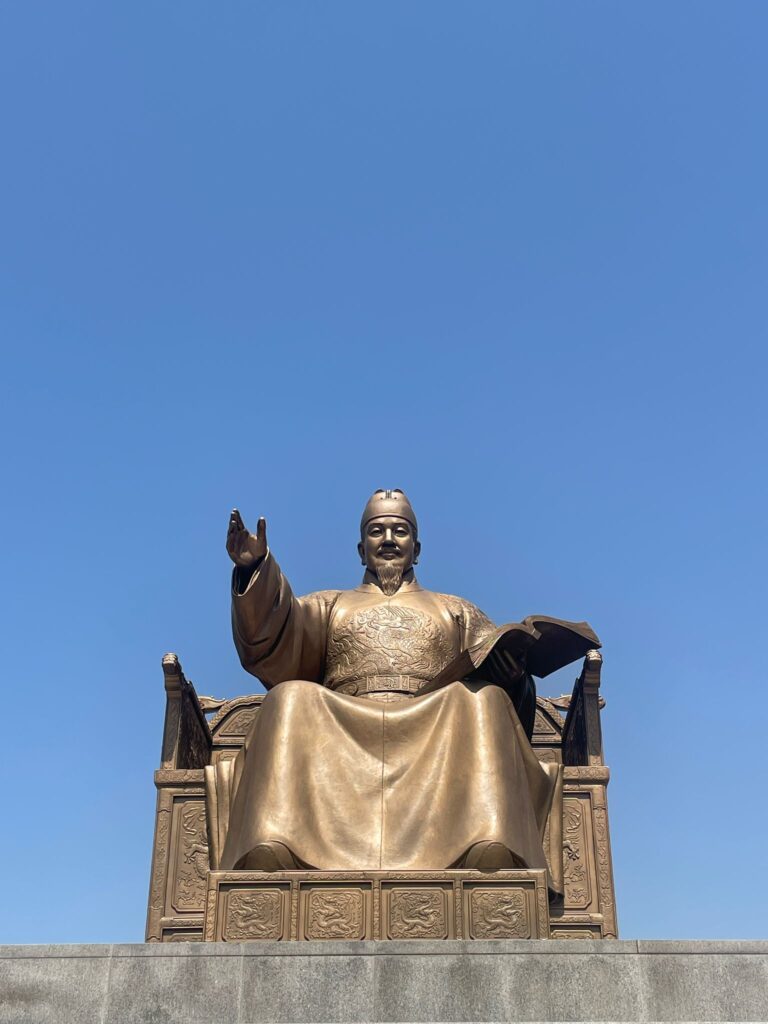
Day 1: Afternoon – Bukchon Hanok Village
Nearest metro station: Anguk (Line 3)
Opening hours: Currently 24/7, although opening hours vary for the shops, restaurants and cafes in the village. 10am-5pm from October 2024 when restrictions will be introduced to combat overtourism
Entry cost: Free
There are two hanok villages in Seoul, both with a different aesthetic and both worth checking out during your 2 days in South Korea’s capital.
Bukchon is the more famous of the two, and this one is more about appearance than activities. Ikseondong has more to do, but Bukchon is the more scenic hanok village.
A hanok village is a small settlement full of buildings built in a traditional Korean manner. Their distinctive design makes them a popular tourist attraction, with their tiled roofs and charming curved appearance.
Spend some time walking up and around the hills of Bukchon, taking in the local sights. Try and walk up to the higher parts of the village, where you will find significantly fewer tourists.
An hour is enough time to get a good feel for the place.
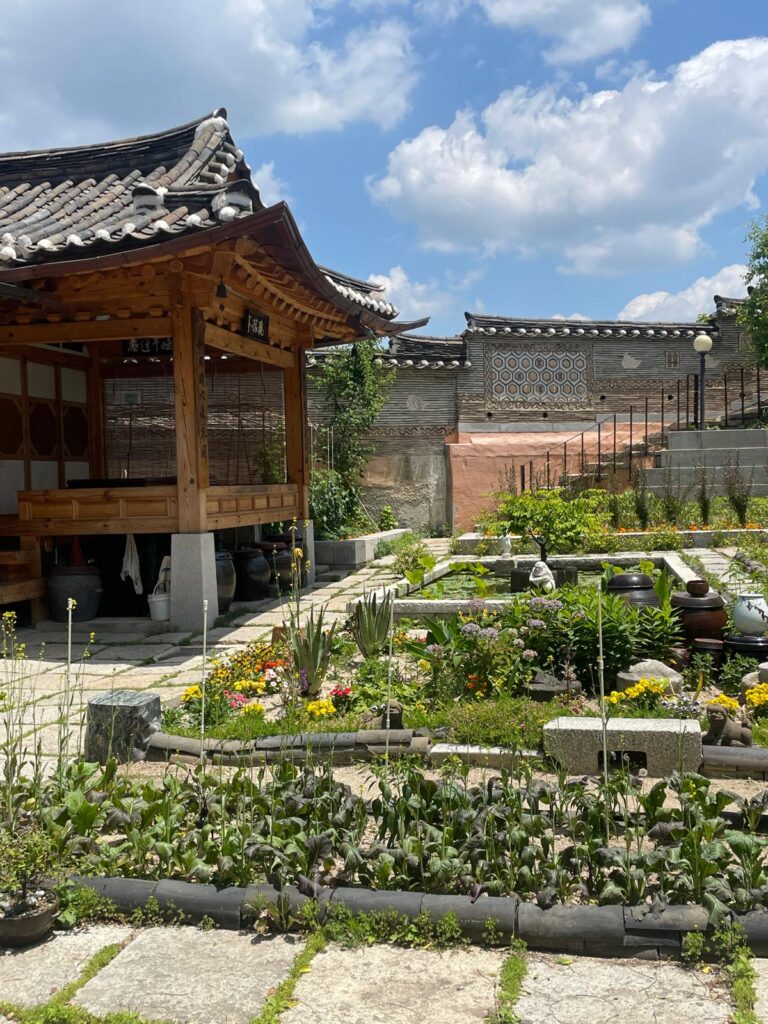
Day 1: Afternoon – Ikseondong Hanok Village
Nearest metro station: Jongno 3(sam)-ga (Lines 1, 3 and 5)
Opening hours: 24/7, although hours vary for all the shops and other establishments in the village
Entry cost: Free
If Bukchon is about style, then Ikseondong is the hanok village for substance. It certainly isn’t as pretty as Bukchon, but there’s a lot of things to do in Ikseondong.
Ikseondong has multiple restaurants. Not just Korean, but also Thai, Italian and Mexican among others. It has several different cafes, and a cool cheese factory which is styled on a farm-type environment.
There are activities aplenty in Ikseondong. If you want to go to arcades and play video games then you can head to Saeseoul. If you want to practice your shooting skills, you can do that at Ikseon Shooting Club for just ₩5,000 (£3/US$4). And if like many Koreans, you just want to take photos alongside props with your friends, there’s no shortage of photobooths in Ikseondong.
You can spend a lot of time here and not get bored. It’s one of my favourite places in Seoul, and I hope you love it as much as I did.
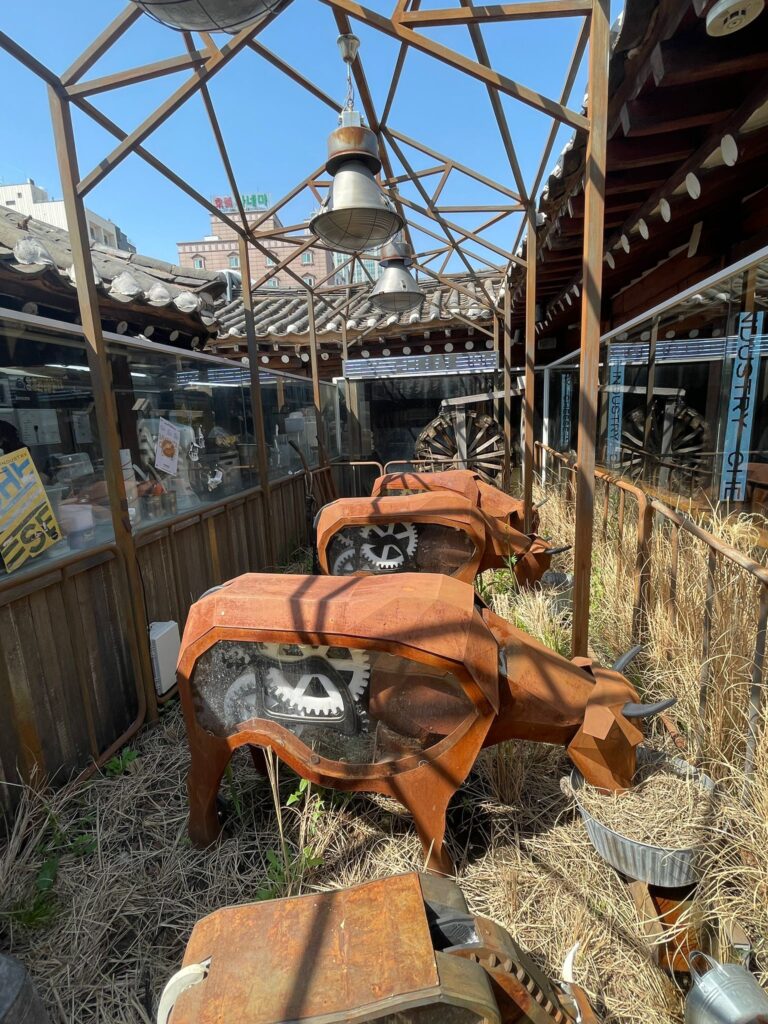
Day 1: Evening – Myeongdong Night Markets
Nearest metro stations: Myeongdong (Line 4) and Euljiro 1(il)-ga (Line 2)
Opening hours: 4pm-10pm daily, although each stall varies and these aren’t strict timings, therefore exact times may be different. However these are the times you should visit between for the full experience
Entry cost: Free
Round off your first day in Seoul by stopping at the most famous night markets in the capital.
Myeongdong is a street food lovers dream, with everything ranging from Americanised treats such as Oreo-flavoured churros to Korean specialities including octopus.
Walk down Myeongdong street after dark, to sample these foods and much more.
Of course, there’s a strong emphasis on Korean food here, but that’s the main reason for coming, right?
Tteokbokki (a form of rice cake) and mandu (dumplings) can be found among many other things here.
Even if you aren’t a foodie, it’s fun to see the night markets and soak up the atmosphere.
I’d certainly recommend at least one trip here during your 2 nights in Seoul.
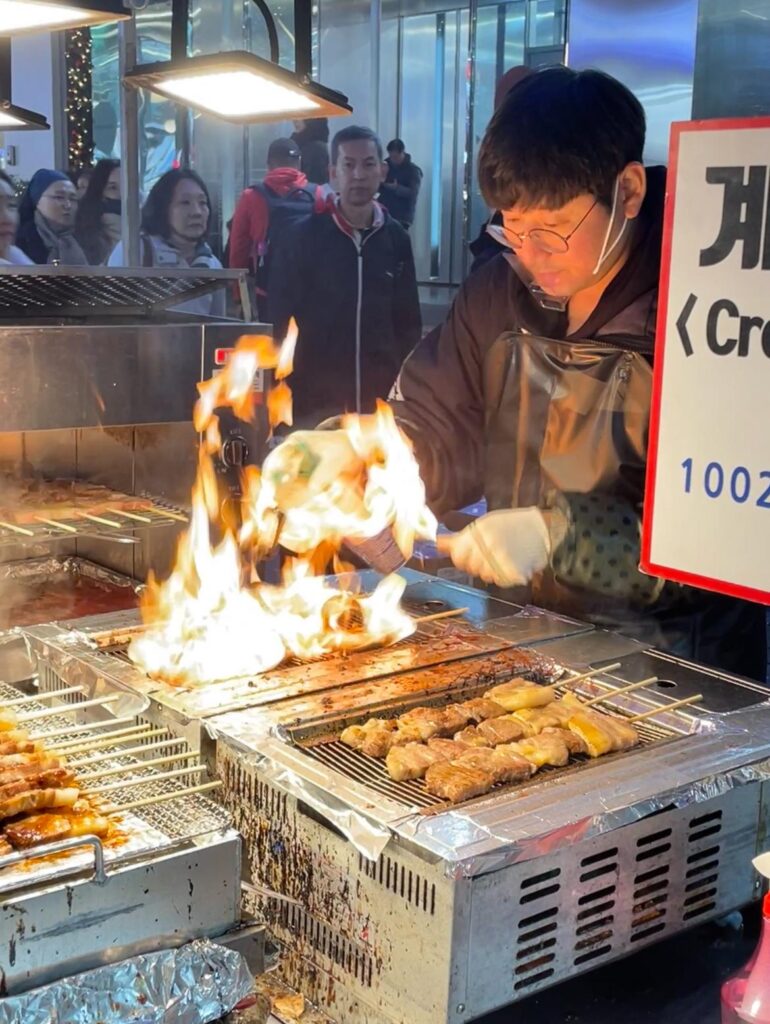
Day 2: Morning – Gangnam Walking Tour
Nearest metro station: Bongeunsa (Line 9)
Opening hours: Sunday, Tuesday and Saturday 10am-1pm and Thursday 4pm-7pm
Entry cost: Free access to all places mentioned below, although walking tours are “tips-based”, therefore you can choose how much to pay for the tour itself
A free walking tour is the best way to see the highlights of a city, and learn all about the history, as well as find out the favourite spots of locals, which may not be so well known for tourists.
Since Seoul is such a gargantuan city, you would have to do multiple walking tours to see everything. With only 2 days in Seoul I would recommend doing the Gangnam free walking tour which I can recommend from personal experience.
You will meet your guide at Bongeunsa Station, and visit the following stops.
Bongeunsa Temple
A Buddhist temple, and one of the most impressive in South Korea. I would say only Beopjusa Temple in Songnisan is better, although Jogyesa Temple in northern Seoul is also pretty cool.
Your guide will show you everything worth seeing in this small complex, starting with the Gate of Heavenly Kings, a common feature at Buddhist temples where four giant statues stand at the entrance, each representing a different compass direction.
You then head past a small Buddhist statue in a pond, up towards the temples themselves which are full of colourful images depicting Buddha’s journey to enlightenment.
If you’re lucky then you may just be able to catch the locals during prayer time. Korean Buddhism is still relatively widespread today with around 16% of the population identifying as Buddhist.
Eventually you will reach the back of the temple, where a giant Buddha statue stands at the back of a courtyard, surrounded by thousands of smaller statues with the names of locals inscribed on them. The locals earned this honour by donating to keep the temple running.
Bongeunsa Temple is a great place to feel like you’re truly in Korea.
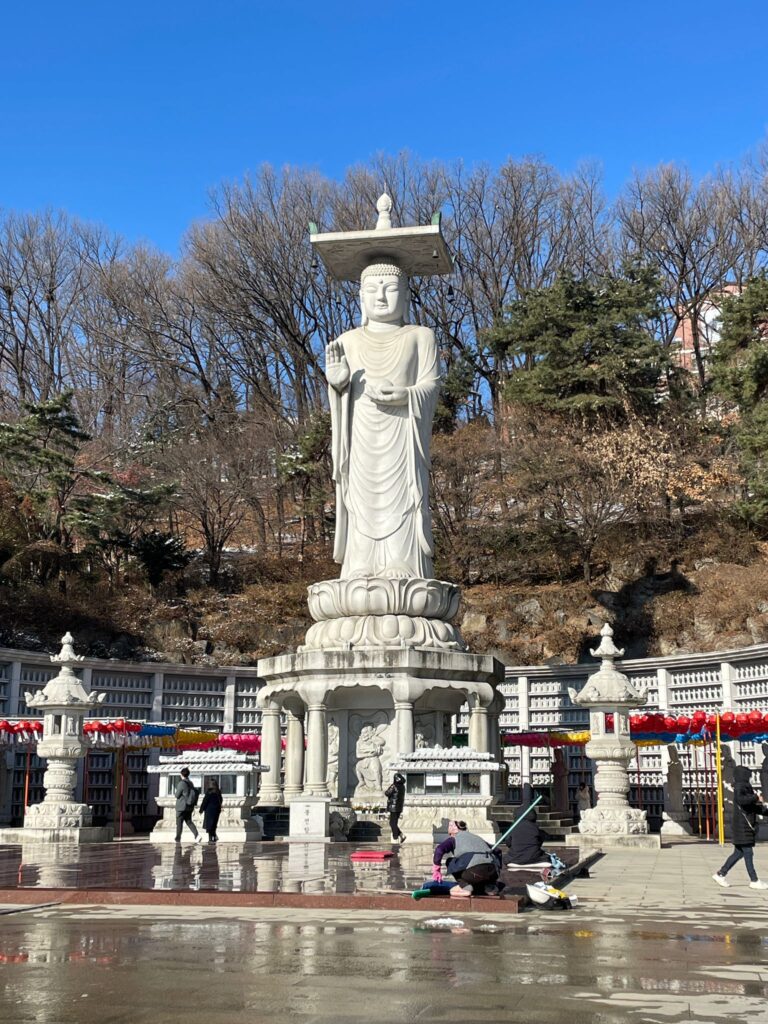
Gangnam Statue
K-pop music has become a global hit in recent years, and many people’s introduction to the genre came in 2012 with the release of the record-breaking song “Gangnam Style” by Korean singer Psy.
The song was an accidental global sensation, having only meant to be popular amongst local Korean fans, and really put South Korea on the modern cultural map.
On the Gangnam walking tour, your guide will talk you through the history of Psy and how he was able to become such a superstar. You will then walk to the Gangnam Style statue, where you can take some photos and videos as the popular song plays in the background.

Starfield Library
The last major stop on the tour will be the Starfield Library at the COEX Mall in Gangnam.
This isn’t a sight that will take long to see. It is popular amongst Instagrammers however due to the sleek aesthetic of the library, with thousands of books stacked neatly right up to the ceiling.
You can take a few photos, treat this stop as a short break, then continue with the tour outside as it goes past a couple of minor stops, and the guide continues to share his knowledge of the area.

Day 2: Afternoon – N Seoul Tower
Nearest metro station: Hoehyeon or Myeongdong (Both Line 4)
Opening hours: 10am-10:30pm on weekdays, 10am-11pm on weekends and holidays
Entry cost: Free to hike up to the base, ₩21,000 (£12/US$15) for adults to enter the tower, ₩16,000 (£9/US$12) for children aged 3-12 or seniors aged 65+ to enter the tower
Cable car cost: ₩15,000 (£8/US$11) for an adult return ticket, ₩12,000 (£7/US$9) for a one-way adult ticket, ₩11,500 (£6/US$8) for a child return ticket and ₩9,000 (£5/US$6) for a one-way child ticket. Children are classified as anyone aged 3-12, and seniors (aged 65+) also qualify for children’s tickets
After Gangnam, head to central Seoul ready to experience one of the city’s greatest viewpoints.
N Seoul Tower, or Namsan Tower as it’s also known can be experienced in multiple ways.
Your first choice is whether or not you want to take the cable car up Namsan Mountain, to reach the base of the tower itself. Naturally the cable car is faster and easier, but walking costs nothing and you can appreciate the views a lot more.
At the top of the mountain, there are often traditional Korean martial arts performances taking place. I saw a swordsman carrying out his routine in front of a large crowd when I came up here.
The next choice you have to make is whether or not you wish to actually enter the tower itself. The views are pretty awesome even without going in.
Again, cost is one of the biggest considerations over whether you go up or stay down.
But as I say, the views are pretty good from outside the tower, so if you’re on a budget then you may want to save the extra ₩21,000.
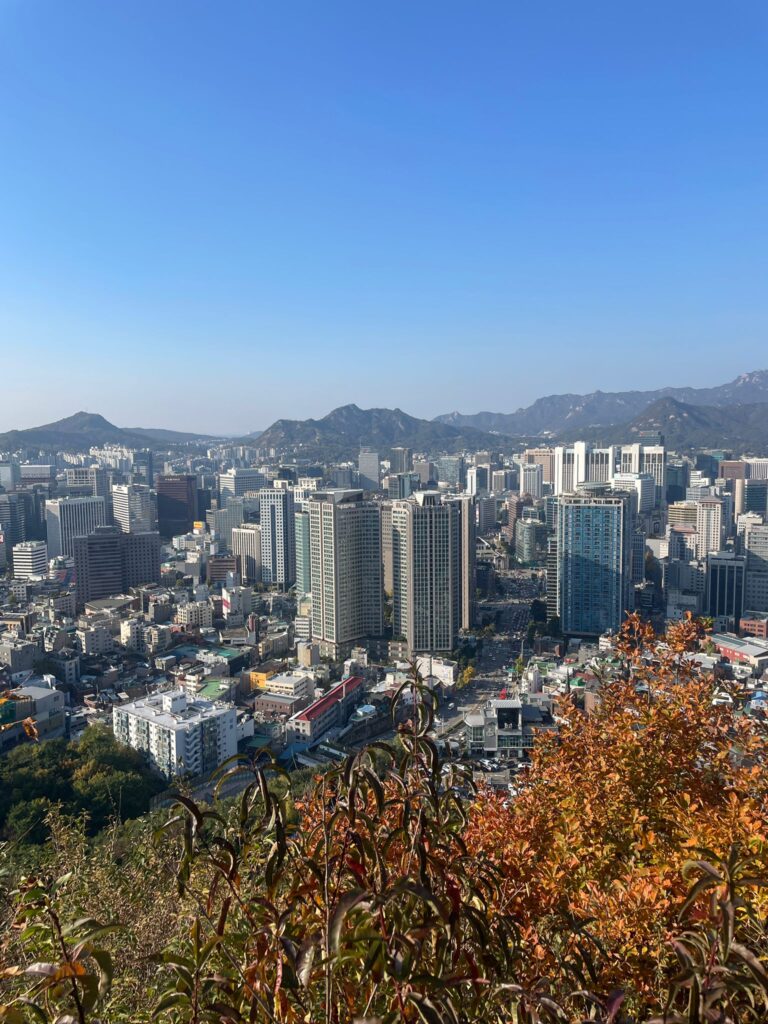
Day 2: Evening – Boing Cafe
Nearest metro station: Euljiro 3(sam)-ga (Lines 2 and 3)
Opening hours: Sunday-Thursday 12pm-12am, Friday-Saturday 12pm-1am
Entry cost: Free
Your last activity in Seoul will be to wind down at one of the city’s many quirky themed cafes.
In this case, Boing Cafe has an aviation theme. Go inside and to your left will be a series of aeroplane-style seats complete with seatbelts, remotes on the armrests and even windows with views of clouds and a wing to resemble being inside a real plane!
There’s even an oxygen mask dangling from the front to complete the authentic aviation experience.
Upon ordering your food or drinks, you will be given a timer allowing you to sit for up to an hour before you have to leave due to the limited space.
The cafe serves not just coffee, but also beers, cakes and juices for children.
A fun way to end your short Seoul adventure.
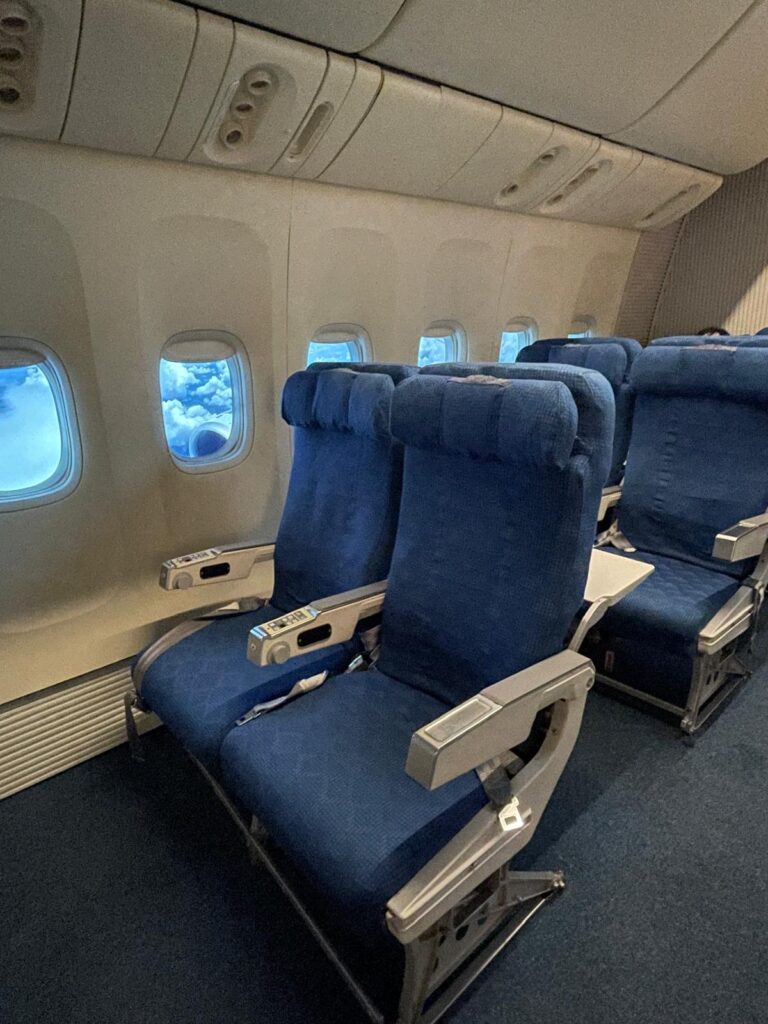
Where to Stay in Seoul
Seoul is a massive city, so it can be tricky to know where to stay for first timers. It’s also pretty expensive to find a place to sleep here.
I would recommend staying in or near Myeongdong. This is the heart of the city, near most of the main attractions. It is well connected with the rest of Seoul, as well as the airport.
Here are some options for accommodation, regardless of your budget:
Budget: Step Inn Myeongdong 1 – This is where I stayed during my first weekend in Seoul, and it’s bang in the middle of Myeongdong. This is cheap by Seoul’s standards, and I can certainly recommend it.
The shared dorm rooms have privacy curtains on the beds and there are large lockers to keep your belongings safe. Step Inn also offers a small breakfast buffet in the morning with a variety of cereals, bread options, savoury foods and more.
Mid-range: OYO Hostel Myeongdong 3 – Just around the corner from Myeongdong Street, this hostel has private rooms, is very clean and offers a basic breakfast option consisting of bread and cereal.
Staff here are very friendly and helpful. They also speak fluent English which isn’t always the case in South Korea, so it’s easy to communicate with them.
Luxury: Lotte Hotel Seoul Executive Tower – Again, just around the corner from Myeongdong Street, this is a real top-of-the-range option with everything you could possibly want.
It has 7 different restaurants, buffet breakfasts, a pool, a spa, a gym and so much more. It’s clean, it’s luxurious, and in the unlikely even you actually want to leave the hotel, they have a help desk where you can arrange tours.
Staying here will truly cap off a magical Seoul stopover experience.
How Much Does it Cost to Visit Seoul?
Seoul is a very affordable city, with the exception of accommodation which can be expensive in peak seasons.
I would budget for £50 (US$63) per day here as an average. That’s ₩90,000 in Korean won.
Accommodation costs start from £7/US$9 for a shared dorm room in a hostel located 4-7km away from the city centre. Private hotel rooms start from around the £20 (US$25) mark, again a few kilometres away from the centre.
Hostels in more central areas are around double (£14 or US$18) whereas private rooms only cost a fraction more (£25/US$31). For these budget prices, the quality obviously isn’t Hilton standard, but it’s still fairly good. South Korea is a country with high standards for the most part.
In the summer (June-August), expect to pay up to treble these prices.
Everything else is super cheap.
A one-way metro ticket costs around £1/US$1.25. I would say on average you will use up to 4 of these maximum per day bringing your daily transport spend to £4/US$5. Most attractions are clustered close together.
Street food is popular in Seoul. You can find meals at the markets for less than £5/US$6, including at Myeongdong’s awesome markets.
Activities are cheap too. Entry to key sites such as Gyeongbokgung Palace is around the £2/US$3 mark, and most attractions have similar prices.
On a budget, I would say you can spend less than £30/US$40 per day in Seoul. Half of that will go on accommodation.
You should at least double that budget if travelling in the summer months.
I suggested a budget of £50/US$63 per day at the beginning of this section to allow some leeway, because that will allow you to spend freely without worrying about splashing out too much. But you can definitely do it for cheaper.
When is the Best Time to Visit Seoul?
Having lived in South Korea as an English teacher for over 9 months, I experienced all four seasons in Korea.
And I can tell you from personal experience that the best time to visit Seoul is in the spring from March-May. More specifically, I would recommend April which is when cherry blossom season is in full flow.
Korean winters (December-February) can be bitterly cold, and summers (June-August) can be punishingly hot. So autumn and spring are certainly the best times to visit.
Although I’d say spring is the better of those two options, mostly due to the cherry blossoms.
Is 2 Days in Seoul Enough?
In all honesty, not really! Two days in Seoul will cover the main highlights, but you should consider staying longer if you get the opportunity.
With one day in the capital, you will have to target a 24-hour Seoul itinerary best suited to your interests, but with a week you will have more time to see everything you want in Seoul, whilst even having time to do some day trips, with visiting the DMZ being one of the best ones.
If you do only have a couple of days however, then following the itinerary in this post will cover all the best parts and give you a good taster of what this city is all about.
What Else Should I Know Before Visiting Seoul?
Firstly, be aware that most western apps have a lot of limitations in South Korea, and you should download the Korean equivalents instead.
Whilst Google Translate is incredibly useful in most countries, it isn’t very good at translating between English and Korean. The local equivalent Papago should be used instead. Although if I’m honest, it’s still far from perfect.
For maps, don’t rely on Google Maps. Offline maps won’t work, and the feature which allows you to work out how long it takes to walk from A to B is also nonfunctional in South Korea. Use Kakao Maps or Naver Maps instead. Both are frustrating to get your head around if you don’t speak Korean, but they do everything you will need them for.
Also make sure you download the Seoul Metro app. It’s by far the easiest way to work out routes on the metro, you can find out exactly how long it should take to get between destinations, and it works both online and offline. It’s better offline as adverts don’t run, whereas the online version forces you to watch them before using the app. I was kicking myself for not downloading this earlier, having only done so on my 4th or 5th visit to Seoul.
The money used in South Korea is the Korean won (₩). You can pay for most things in Seoul by card. Although I would advise withdrawing a small amount of won, mostly for the Seoul metro where tickets are cheap and you will receive a ₩500 deposit back for returning your one-way metro cards after each use.
Now one important aspect of travel is safety. Fortunately, there’s not too much to worry about in South Korea, which has super low crime rates. Just wrap up warm in the winter and hydrate a lot in the summer, because the weather is just about the biggest issue here.
Oh, and traffic… Just be sure to cross the roads at a designated crossing point. It’s illegal to cross anywhere else, or whilst a pedestrian crossing light is red.
I did write a solo travel guide for South Korea which has useful tips, regardless of whether you’re alone or with others.
Lastly, if you’re still stuck and you need a Seoul trip planner, I’m happy to assist you with that! I offer travel planning services and can give you some good advice having spent 9 months teaching English in Korea.
This city is wonderful and I hope you have the best possible time here. Follow my Seoul itinerary and you will see the best the city has to offer before you head off to your next destination.
More Posts on South Korea
- 2 Day Seoul Itinerary: Highlights Of South Korea’s Capital
- An Expat’s Guide To Solo Travel In South Korea
- When Is The Best Time To Visit South Korea?
- Exploring Korea: Is The DMZ Worth Visiting In 2025?
- A Guide To Visiting Ikseon-dong Hanok Village In 2024
- One Day In Seoul: 24 Hour Itinerary For South Korea’s Capital
- A Tourist’s Guide To Visiting Beopjusa Temple In 2024
- Requirements For Teaching English In South Korea In 2024
- A Beginner’s Guide To Teaching English In South Korea In 2024
